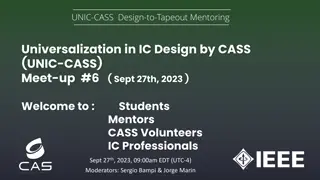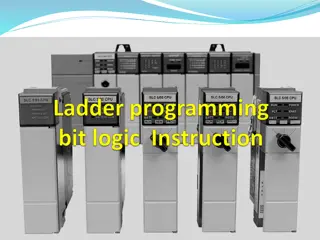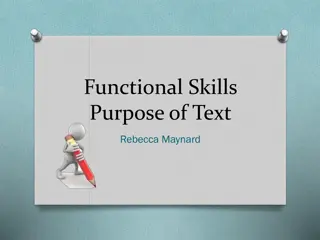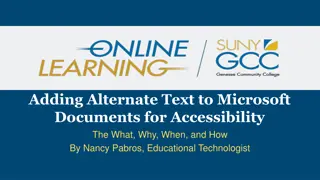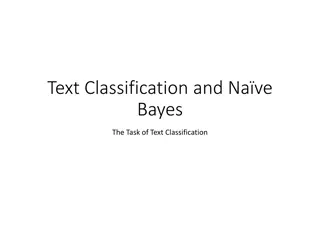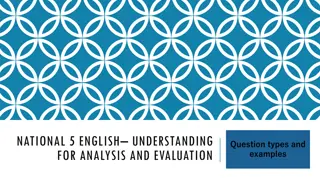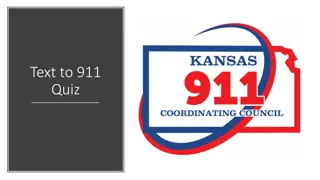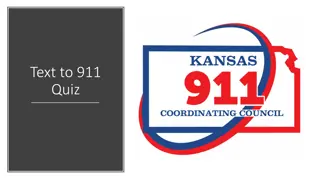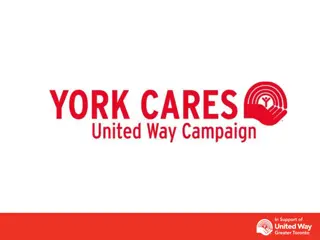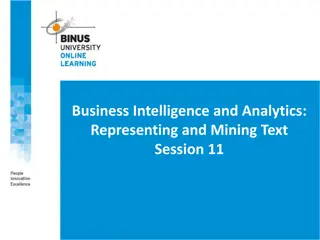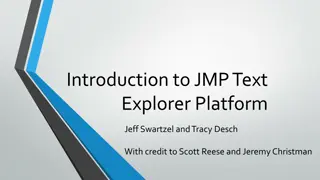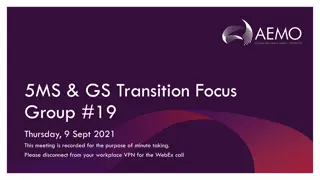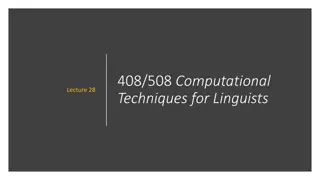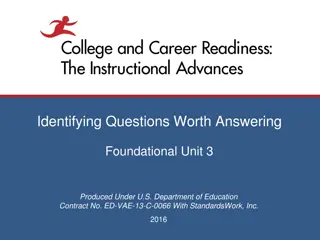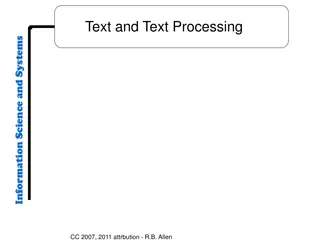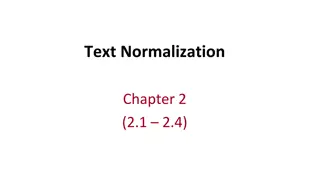
Rethinking Reading Instruction: Moving Beyond Text Levels
Explore the reasons behind the shift to text complexity in reading instruction, highlighting the ineffectiveness of using below-grade-level texts and the importance of reconceptualizing reading as making sense of ideas, rather than answering questions. Learn about common classroom responses to text complexity and the historical context of why easy texts were once prioritized in education.
Download Presentation

Please find below an Image/Link to download the presentation.
The content on the website is provided AS IS for your information and personal use only. It may not be sold, licensed, or shared on other websites without obtaining consent from the author. If you encounter any issues during the download, it is possible that the publisher has removed the file from their server.
You are allowed to download the files provided on this website for personal or commercial use, subject to the condition that they are used lawfully. All files are the property of their respective owners.
The content on the website is provided AS IS for your information and personal use only. It may not be sold, licensed, or shared on other websites without obtaining consent from the author.
E N D
Presentation Transcript
Doing Away with the Instructional Level Timothy Shanahan University of Illinois at Chicago www.shanahanonliteracy.com
Reasons for the shift to text complexity By the time students leave high school they should be able to read well enough to succeed in higher education, the workplace, and/or the military Large percentages of students cannot read the texts that would allow them to do these things (Achieve, 2015; Military Officers Association of America, 2018; Williamson, 2006; Workforce Readiness Project, 2006)
Reading Comprehension Instruction Most teachers teach reading using below grade level texts (Shanahan, 2013; Griffith & Duffett, 2018) They do this because of an untested theory formulated in the 1940s that claimed that students would learn best if taught from texts at their reading levels (rather than their grade levels) Much reading comprehension instruction is reading practice with relatively easy texts and a focus on either answering certain kinds of questions or applying strategies
Reconceptualization of reading Reading comprehension is not the ability to answer certain kinds of text questions Reading is the ability to make sense of ideas expressed in text the ability to negotiate the linguistic and conceptual barriers or affordances of a text
Four Common Classroom Responses to Text Complexity Read text to students (communicates the information, but doesn t increase student reading ability) Move students to easier text Tell students what texts say (same as reading to kids in its impact) Ignore the problem (assigning text and students sink or swim)
Why Easy Text? In the 19th Century, the emphasis in education was on trying to attract students to schools it was believed that easy lessons would accomplish that This led to dividing schools into grade levels and matching the difficulty of the textbooks to the grade levels By the 20th Century, it became apparent that there was a great deal of variation in student reading ability within grade, and they wanted to differentiate teaching to accommodate this variation This led to a 30-year search for a system that would provide this accommodation aimed at making the texts easy enough for all students
Instructional Level The idea that caught on and gained popularity was one put forth by Emmett Betts (1946) Betts believed that students have 3 reading levels Independent texts would be easy for students to read successfully on their own Instructional level texts would facilitate learning they would pose a modest level of challenge that could easily be overcome with teacher support Frustration level texts were thought to be too hard to comprehend even with quality teaching
Instructional Level (cont.) Betts believed that for instruction to be successful reading lessons must result in comprehension Text challenge was to be avoided, and instruction minimized (students should be able to overcome a text s difficulties with minimal support) Independent (fluency 99-100%; comprehension 90-100%) Instructional (fluency 95-98%; comprehension 75-89%) Frustration (fluency 0-92%; comprehension 0-50%)
Instructional Level (cont.) Since Betts other authorities have recommended modest adjustments to the idea For example, Gickling (a special educator) suggested that 93-97% is the true instruction level Marie Clay believed that 90% accuracy was instructional level for struggling first graders who were receiving 1-on-1 instruction, and Fountas and Pinnell extended this up the grades and to regular classroom instruction In all cases, the theory is the same match kids to books appropriately and the result will be more learning None of these theories provided evidence showing this to be the case
Research on Text Levels and Learning 1 Killgallon (1942): only looked at the relationship of oral reading fluency and reading comprehension not learning Powell (1968): same methodology as Killgallon, but more grade levels and different results more than one instructional level, and accuracy could be in the low-to- mid 80%s Dunkeld (1981): students taught at frustration level made greatest learning gains
Research on Text Levels and Learning 2 Jorgensen, et al. (1977): no relation between placement and achievement gains McNamara, et al. (1996): middle school students learned more content from texts that were hard for them Morgan, et al. (2000): frustration level placements led to greater learning gains in reading Brown et al. (2017): replicates this result with third grade
Research on Text Levels and Learning 3 O Connor et al (2002): Only benefit was for LD students reading at grade 1 level or lower O Connor et al (2010): But this benefit went away even for those students, if scaffolding was equated Kuhn et al (2006): frustration level placement led to greater learning gains FORI instruction more effective than Guided Reading
Research on Text Levels and Learning 4 Homan, et al., (2010): teaching 6th graders with instructional level text gave no advantage over teaching with text one year above instructional level Lupo, et al. (2019): grade level text led to as much learning as easier texts with 9th graders (content and reading) with instructional support
Summary of Research None of the studies show any learning advantage to placing students at their instructional levels Students either did better with more challenging text or there were no advantages to placing students in easier text When there was instruction tailored to the more difficult texts more substantial learning advantages appeared even for students with learning disabilities
Summary of Research All these studies were conducted in Grade 2 through high school There are no beginning reader studies I suspect that the need to develop basic decoding abilities is better served with relatively easy text text in which students will be more able to notice spelling patterns and with greater word repetition Once students have the decoding abilities that allow them to read like an average end of year first grader, they should be able to learn successfully from more challenging text Instead of avoiding difficulty, we need to teach readers how to surmount it
Why Doesnt It Work? For instructional level/leveled books approaches to work three mechanisms must work First, the assessments (e.g., IRIs, Running Records, Curriculum-Based Assessments) must provide an accurate estimate of students reading levels Second, the readability or leveling system must estimate text levels accurately Third, the differentiation scheme (small group instruction with different levels texts) must accelerate learning
Why Doesnt It Work? (cont.) None of those three requirements works very well First, the assessments have standard errors of measurement that are larger than the criteria they aim to identify this means students will often be placed 1-2 grade levels differently upon retesting Second, text leveling systems suffer similar problems which means you have two Third, small group instruction is more powerful than whole class instruction, but small group teaching usually accompanies reductions in the amount of teaching (and grouping schemes tend to resegregate classrooms and have especially bad results for minority children)
Teaching with Grade Level Text Teaching with grade level text expands students opportunity to learn It allows students to take on content and language better aligned to their age and interests However, it alters the nature of differentiation Instead of teaching students a different curriculum, differentiation must come from different degrees of instructional support
Teaching with Grade Level Text (cont.) When teachers teach reading with texts at students instructional levels, the amount that students can learn is limited and the amount of teaching that is needed will be limited as well With more challenging text, there is greater opportunity to learn (since there are more linguistic and conceptual misunderstandings that such a text poses) That means there is a greater need for teachers to try to identify incomprehension and miscomprehension and to address those through instruction
Research on Teaching with Challenging Text The following studies intentionally taught students with frustration level texts and scaffolded that reading in one or more ways that allowed students to perform in the harder texts as if they were at the instructional level In other words, instructional support transformed frustration level texts into instructional level ones
Research on Teaching with Challenging Text (cont.) Pany & McCoy, 1988 Rasinski, 1990 Reitsma, 1988 Rose & Beattie, 1986 Sanford & Horner, 2013 Sindelar, Monda, & O Shea, 1990 Smith, 1979 Stoddard, Valcante, Sindelar, O Shea, et al., 1993 Taylor, Wade, & Yekovich, 1985 Turpie & Paratore, 1995 VanWagenen, Williams, & McLaughlin, 1994 Weinstein & Cooke, 1992 Wixson, 1986 Bonfiglio, Daly, Persampieri, & Andersen, 2006 Burns, 2007 Burns, Dean, & Foley, 2004 Carney, Anderson, Blackburn, & Blessings, 1984 Daly & Martens, 1994 Eckert, Ardoin, Daisey, & Scarola, 2000 Faulkner & Levy, 1999 Gickling & Armstrong, 1978 Hall, Sabey, & McClellan, 2005 Levy, Nicholls, & Kohen, 1993 McComas, Wacker, & Cooper, 1996 Neill, 1979 O Shea, Sindelar, & O Shea, 1985
Scaffolding Challenging Text Scaffolding Text Features Complexity of ideas/content Match of text and reader prior knowledge Complexity of vocabulary Complexity of syntax Complexity of coherence Familiarity of genre demands Complexity of text organization Subtlety of author s tone Sophistication of literary devices or data-presentation devices Other Approaches Provide sufficient fluency Use stair-steps or apprentice texts Teach comprehension strategies Motivation
Build Text Reading Fluency Texts can be hard because they demand more advanced reading skills than the students have Students need practice reading (orally) with accuracy, appropriate speed, and prosody With some students it makes sense to start with fluency work rather than ending with it let s increase fluency for a text and then focus on comprehension Not round-robin reading (use these instead: repeated reading, echo reading, paired reading, reading while listening, etc.) Putting fluency first might make sense Parsing texts can be helpful
A Walk in the Desert Sunbeams are flickering over the landscape as the sun rises. A kit fox heads for her den as another day in the desert begins. Deserts are surrounded by other kinds of landscapes. Scientists call these different land zones biomes. All the plants and animals in a biome form a community. In that community, every living thing depends on other community members for its survival. A biome s climate, soil, plants, and animals are all connected this way.
A Walk in the Desert Sunbeams/ are flickering/ over the landscape/ as the sun rises./ A kit fox/ heads/ for her den/ as another day/ in the desert/ begins./ Deserts/ are surrounded/ by other kinds of landscapes./ Scientists/ call/ these different land zones/ biomes. All the plants and animals/ in a biome/ form/ a community./ In that community,/ every living thing/ depends/ on other community members/ for its survival./ A biome s climate, soil, plants, and animals/ are all connected/ this way./
Provide Stair-step Text Sets Texts can be hard because students lack sufficient background knowledge If students have multiple texts on the same topic that are at different difficulty levels, easier apprentice texts can help students build background knowledge for the more difficult ones. The overlap in important information should increase the likelihood that students will pay attention to it. Should increase a student s ability to independently deal with the information in the hard text
Vocabulary Texts can be hard because of unfamiliar vocabulary (difference between academic vocabulary and key vocabulary in a text) We teach vocabulary, but there are two major goals in vocabulary teaching: (1) building a lexicon; (2) enabling immediate understanding of text Our interest today is more on the second of these goals We tend to preteach/pre-introduce new vocabulary prior to reading to facilitate success with harder texts
Which words do you teach? Photosynthesis may sound like a big word, but it's actually pretty simple. You can divide it into two parts: "Photo" is the Greek word for "Light," and "synthesis," is the Greek word for "putting together," which explains what photosynthesis is. It is using light to put things together. You may have noticed that all animals and humans eat food, but plants don't eat anything. Photosynthesis is how plants eat. They use this process to make their own food. Since they don't have to move around to find food, plants stay in one place, since they can make their food anywhere as long as they have three things.
Which words do you teach? Photosynthesis may sound like a big word, but it's actually pretty simple. You can divide it into two parts: "Photo" is the Greek word for "Light," and "synthesis," is the Greek word for "putting together," which explains what photosynthesis is. It is using light to put things together. You may have noticed that all animals and humans eat food, but plants don't eat anything. Photosynthesis is how plants eat. They use this process to make their own food. Since they don't have to move around to find food, plants stay in one place, since they can make their food anywhere as long as they have three things.
Which words would you teach? Some scientists argued that these gases have heated up our atmosphere. They say global warming will affect our climate so dramatically that glaciers will melt and sea levels will rise. In addition, it is not just our atmosphere that can be polluted. Oil from spills often seeps into the ocean.
Which words would you teach? I can never forget the scene that met us. Between us and the Barrier was a lane of some fifty yards wide, a seething cauldron. Bergs were calving off as we watched: and capsizing: and hitting other bergs, splitting into two and falling apart. The Killers filled the whole place. Looking downwards into a hole between our berg and the next, a hole not bigger than a small room, we saw at least six whales. They were so crowded that they could only lie so as to get their snouts out of the water and my memory is that their snouts were bottle-nosed. At this moment our berg split into two parts and we hastily retreated to the lower and safer floes.
Which words would you teach? I can never forget the scene that met us. Between us and the Barrier was a lane of some fifty yards wide, a seething cauldron. Bergs were calving off as we watched: and capsizing: and hitting other bergs, splitting into two and falling apart. The Killers filled the whole place. Looking downwards into a hole between our berg and the next, a hole not bigger than a small room, we saw at least six whales. They were so crowded that they could only lie so as to get their snouts out of the water and my memory is that their snouts were bottle-nosed. At this moment our berg split into two parts and we hastily retreated to the lower and safer floes.
Comprehending Sentences Reading requires more than an ability to make sense of word meanings Comprehension also depends on one s ability to make sense of syntax, too Formal grammar instruction has not been found to have much impact on comprehension but it is possible to teach it successfully in applied ways
Sentence Complexity Gamers have had enough of reality. They are abandoning it in droves a few hours here, an entire weekend there, sometimes every spare minute of every day for stretches at a time in favor of simulated environments and online games.
Sentence Complexity Gamers [They] are abandoning reality [it] in droves a few hours here, an entire weekend there, sometimes every spare minute of every day for stretches at a time in favor of simulated environments and online games.
Sentence Complexity Gamers [They] are abandoning reality [it] in droves a few hours here, an entire weekend there, sometimes every spare minute of every day for stretches at a time in favor of simulated environments and online games. a few hours here an entire weekend there Sometimes every spare minute of every day for stretches at a time
Sentence example However, on August 24, 2006, the International Astronomical Union (IAU), a group of individual astronomers and astronomical societies from around the world, made an announcement. --25 words --5 commas
Sentence example However, on August 24 2006 the International Astronomical Union (IAU), a group of individual astronomers and astronomical societies from around the world made an announcement
Sentence example Who was the sentence about? the International Astronomical Union (IAU) Who are they? a group of individual astronomers and astronomical societies from around the world What did they do? made Made what? an announcement When? on August 24 2006
Another example The women of Montgomery, both young and older, would come in with their fancy holiday dresses that needed adjustments or their Sunday suits and blouses that needed just a touch a flower or some velvet trimming or something to make the ladies look festive. --Nikki Giovanni (Rosa) 44 words 2 commas, 1 em-dash
The women of Montgomery , both young and older, would come in with their fancy holiday dresses that needed adjustments or their Sunday suits and blouses that needed just a touch a flower or some velvet trimming or something to make the ladies look festive.
The women of Montgomery would come in with their fancy holiday dresses that needed adjustments or their Sunday suits and blouses that needed just a touch a flower or some velvet trimming or something to make the ladies look festive.
The women of Montgomery would come in with their fancy holiday dresses that needed adjustments or their Sunday suits and blouses that needed just a touch a flower or some velvet trimming or something to make the ladies look festive.
Another example The women of Montgomery would come in with their fancy holiday dresses that needed adjustments or their Sunday suits and blouses that needed just a touch a flower or some velvet trimming or something to make the ladies look festive.
Another example The women of Montgomery would come in with their fancy holiday dresses that needed adjustments or their Sunday suits and blouses that needed just a touch a flower or some velvet trimming or something to make the ladies look festive.
Another example The women of Montgomery would come in with their fancy holiday dresses that needed adjustments or The women of Montgomery would come in with their Sunday suits and blouses that needed just a touch a flower or some velvet trimming or something to make the ladies look festive.
Identify challenging sentences? Particularly long sentences Internal punctuation Dependent clauses Multiple phrases Parentheticals Passive voice Etc. Write a question for the sentences Break the sentences down (punctuation, conjunctions, demonstrative pronouns, prepositions, etc.)
Help with Cohesion Texts can be hard because the relationships and connections may be unclear to readers The killer whale tosses the penguin into the air and generally torments its prey before it eats it The killer whale tosses the penguin into the air and generally torments the penguin before eating it.
Meanwhile, the nebula continued to orbit the new Sun until it formed a large flat ring around it. Scientists call this ring a protoplanetary disk. The disk, or ring, was hottest where it was closest to the Sun, and coolest at its outer edge. As the disk swirled around the Sun, the Sun s gravity went to work. It pulled and tugged at the bits of rock, dust, ice, and gas until they came together in clumps of material we now call the planets.
Meanwhile, the nebula continued to orbit the new Sun until it formed a large flat ring around it. Scientists call this ring a protoplanetary disk. The disk, or ring, was hottest where it was closest to the Sun, and coolest at its outer edge. As the disk swirled around the Sun, the Sun s gravity went to work. It pulled and tugged at the bits of rock, dust, ice, and gas until they came together in clumps of material we now call the planets.



